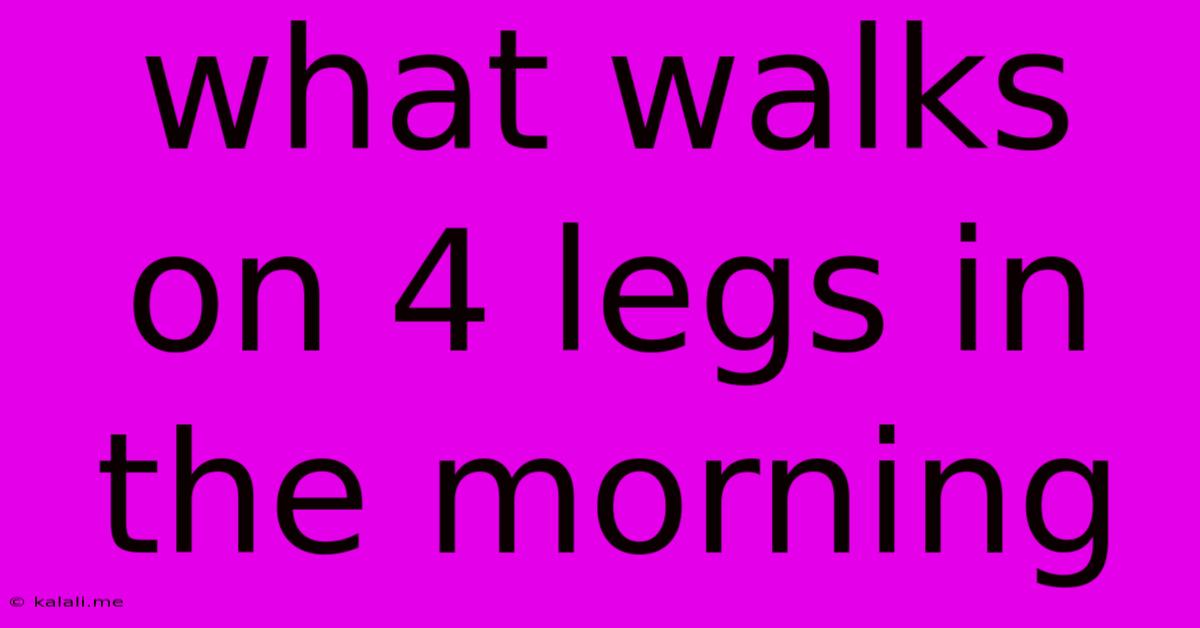What Walks On 4 Legs In The Morning
Kalali
Jun 02, 2025 · 3 min read

Table of Contents
What Walks on Four Legs in the Morning, Two in the Afternoon, and Three in the Evening? A Riddle Solved
This age-old riddle, "What walks on four legs in the morning, two in the afternoon, and three in the Evening?", has stumped many for centuries. Its clever wordplay and allegorical nature have made it a classic. But what's the answer? And what does it really mean? Let's delve into this fascinating puzzle and uncover its secrets.
The Answer: A Human Being
The answer to the riddle is a human being. Let's break down why:
-
Morning (Four Legs): In the morning of life, as infants, humans crawl on all fours. This is the stage of complete dependence and vulnerability.
-
Afternoon (Two Legs): In the afternoon of life, during adulthood, humans walk upright on two legs. This represents the prime of life, independence, and strength.
-
Evening (Three Legs): In the evening of life, during old age, humans often use a cane or walking stick for support, effectively walking on three legs. This symbolizes the decline of physical abilities and the need for assistance.
This simple yet profound explanation reveals the riddle's powerful message about the cyclical nature of life and the inevitable progression from infancy to old age.
The Deeper Meaning and Symbolism:
Beyond the literal answer, the riddle carries a deeper symbolic meaning. It represents:
-
The Passage of Time: The riddle cleverly uses the stages of a day to mirror the stages of human life, highlighting the inexorable march of time.
-
Physical Decline: The shift from four legs to three emphasizes the physical changes and limitations that accompany aging.
-
The Circle of Life: It speaks to the cyclical nature of existence, reminding us that life is a journey with a beginning, a peak, and an eventual end.
-
Vulnerability and Dependence: The image of crawling on four legs speaks to our initial vulnerability and dependence on others, contrasting sharply with the later need for support in old age.
The Riddle's Enduring Popularity:
The riddle's enduring appeal lies in its simplicity and cleverness. It's easily understood yet subtly profound, sparking curiosity and prompting thoughtful consideration of life's stages. Its allegorical nature allows for multiple interpretations, making it a topic of discussion and debate. This contributes to its continued popularity across generations and cultures.
Variations and Interpretations:
While the human being interpretation is the most common, some variations exist. However, these largely revolve around the same core theme of the cyclical nature of life and physical changes over time. The power of the riddle lies in its ability to resonate with different audiences and spark different interpretations.
Conclusion:
The riddle "What walks on four legs in the morning, two in the afternoon, and three in the evening?" is more than just a word puzzle. It's a timeless allegory representing the journey of human life, from infancy to old age, highlighting the passage of time and the inevitable physical changes we all experience. Its enduring appeal lies in its ability to connect with us on a deeper level, prompting reflection on the transient nature of life and the beauty of each stage of our journey.
Latest Posts
Latest Posts
-
Do Non English Names Come Last
Jun 04, 2025
-
What Does Mean At The End Of A Sentence
Jun 04, 2025
-
Mac Sonoma Mail Signature Quesiton Mark
Jun 04, 2025
-
Curb Took Chunk Out Of Tire
Jun 04, 2025
-
How Long Does Stainless Steel Last
Jun 04, 2025
Related Post
Thank you for visiting our website which covers about What Walks On 4 Legs In The Morning . We hope the information provided has been useful to you. Feel free to contact us if you have any questions or need further assistance. See you next time and don't miss to bookmark.